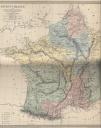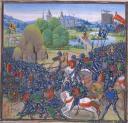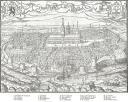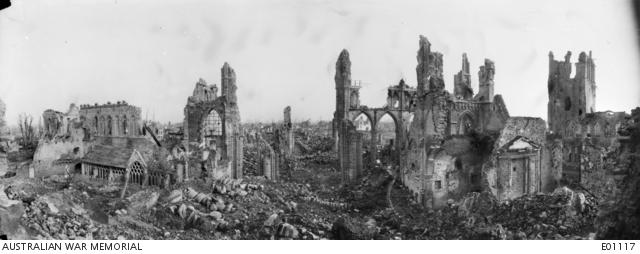A Brief Military History of Flanders
For much of its history Flanders has been a strategically important area during the centuries of conflict in Europe. Ypres, as a major town of the region and a wealthy economic centre, has often been a focal point of the fighting there. Flanders’ location has also put it at the crossroads between long-time rivals England and France, and later as part of the Netherlands territories of other great powers, such as Spain and Austria. Accordingly, this ‘fatal avenue’ (as Charles de Gaulle named it), has so frequently been cursed by the scourge of war that it surely ranks among those regions of the world that throughout history have seen far more than its fair share of destruction, death and misery.


From the Romans to the Franks
By the First Century BC, the region was inhabited by people of mixed Celtic and Germanic origins, predominantly the Morini, the Manapii, and Nervii tribes. In 58 BC Julius Caesar at the head of a powerful army commenced his conquest of Gaul and by the following year as he pushed north, first encountered these tribes. The Romans referred to all the tribes of the north collectively as the Belgae, and soon learned they were fearsome opponents; fierce and determined in battle and implacable in their resistance to Roman rule.
In 57 BC the Belgae tribes led by the Nervii united and attacked Caesar’s legions in the vicinity of the Sambre River, to the south of present day Valenciennes. The Belgae launched a spirited attack en masse that caught Caesar’s eight legions completely off guard. After an extremely vicious and bloody battle, the Romans prevailed, but they had come perilously close to being overwhelmed and wiped out.
Roman rule was soon imposed in the region, however in 54 BC the Belgae rose in revolt, this time led by Ambiorix, chieftan of the Eburones, a tribe from further east towards the Rhine. On this occasion the entire Roman garrison of Aduatuca (a fortified encampment near present day Tongeren), were massacred after being lured from it by a ruse. Soon, other Belgae tribes including the Nervii and Menapii joined the revolt and it seemed the Romans would lose their hold on northern Gaul. Julius Caesar however was not easily rattled and before long he led a force into the region and harshly crushed the revolt. Two years later in 52 BC, the Belgae again fought the Romans in the last great, but ultimately doomed uprising of Vercingetorix. In the long run, Roman military power and their ability to prevent the disparate tribes forming alliances against them, eventually led to the complete conquest and pacification of Gaul. The Belgae territory then became known as the Roman province of Gallia Belgica.

Following the collapse of the Roman Empire in west in the 5th Century AD the region witnessed a period of invasion from the east by the Huns and the Franks. The Franks eventually established control over Gaul, most notably under Charlemagne who ruled from 768-814 AD. In the mid 9th Century, Viking raids became a terrifying feature of life in Flanders. When the Frankish Empire was divided up in 843, the Scheldt River became the demarcation line between the Western and Eastern Frankish kingdoms. In 862 the Western Frankish king, Charles the Bald's daughter married Baldwin I and was appointed count of the newly created County of Flanders.
12th and 13th Centuries
During the later medieval period, Flanders’ importance and wealth grew with Ypres especially prosperous due to its production of cloth and increasingly strong economic ties with England. As a result of its wealth, Flanders and Ypres often became a focal point for the ongoing conflicts over territory and influence between France and England.
Flanders long resisted French hegemony during this period, however Ypres was captured and held at times by successive French kings, notably in 1128 and 1213. Significantly, the French king Philip II then faced an anti-French alliance of Flanders with King John of England and the Holy Roman Empire. However Philip defeated this coalition at the Battle of Bouvines in 1214.

This state of affairs became a much more serious contest following Flanders’ renewed alliance with Edward I (Longshanks) of England in 1297, leading to another French invasion. An English expeditionary force came to Flanders in support, however a major Scottish independence uprising led by William Wallace suddenly flared up not long after Edward’s arrival. The English king persisted in Flanders for several months, but following an English defeat in Scotland at the Battle of Stirling Bridge, his attention was increasingly turned towards home. Early in 1298 Edward and his troops returned to England effectively abandoning his allies. As France imposed its power over Flanders, this latest wave of French oppression inspired even greater resentment and revolt throughout the region, culminating in the massacre of the French inhabitants of Bruges in May 1302. In response to this outrage, a French army was sent to destroy the rebellion. On 11 July however the French were comprehensively defeated by a Flemish peasant army including a contingent from Ypres at the Battle of the Golden Spurs near Courtrai (Kortrijk).

The euphoria was short-lived however as France regrouped and defeated the Flemish two years later at the Battle of Mons-en-Pévèle, about 20 km south of Lille. The resulting treaty provided some measure of Flemish independence at the cost of three of their towns (Lille, Douai and Bethune) ceded to the French. As the years went by however, Flanders gradually slipped under French domination again. A major peasant revolt broke out in Flanders in 1323, but eventually Count Louis I of Flanders with the aid of the King of France, finally crushed the uprising at the Battle of Cassel on 23 August 1328.

The Hundred Years War and the Great Papal Schism The Hundred Years War was fought between France and England, over a period of actually 116 years from 1337 to 1453. It’s main cause was due to claims by English kings to the French throne.
For most of this war Flanders and Ypres managed to stay relatively neutral and safe, however this all changed as something of a sideshow conflict emerged in 1378. The election of Pope Urban VI caused the Great Papal Schism, with England siding with Urban, and France with the rival pope (or antipope), Clement VII. Flanders itself by this time had become a region of divided loyalties along Francophile and Anglophile lines and therefore a flashpoint for this conflict.
In November 1382 a French army soundly defeated the Ghentois (forces of the town of Ghent who supported Pope Urban) at the Battle of Westrozebeke (Roosebeke), just a few miles to the east of Ypres. In fact the location of this clash was only a few hundred metres north of Passchendaele on a hill called the Goudberg. After this battle almost all of Flanders, except for Ghent, again fell under French rule and aligned with them (willingly or not), in support of Clement.

Then in 1383 Pope Urban proclaimed a crusade against Clement. As part of this crusade, the Bishop of Norwich led an English army across the Channel in mid 1383 where he set about capturing the towns of Flanders, allied with the Ghentois who had unsuccessfully besieged Ypres earlier in the year. At the behest of the Ghentois, the Bishop’s forces commenced a renewed siege of Ypres in June, deploying a heavy siege gun (named the Canterbury gun), and a trebuchet. After eight weeks however, Ypres was still holding out and the siege was abandoned upon the approach of a powerful French army. The English withdrew to the coast at Dunkirk and were soon forced to abandon their crusade altogether. As in most wars, the civilian inhabitants of Flanders suffered greatly during this time.
Habsburg rule: the Spanish
The following year (1384) the ‘Seventeen Provinces’ that encompassed parts of northern France, Flanders, and modern-day Belgium and the Netherlands, came under the rule of France via the Duke of Burgundy. A century later in 1482 through royal inheritance, control of these provinces passed from French (Burgundian) rule to that of the Habsburgs, initially the Austrian branch of that royal family, then in 1556 the Spanish branch. Thereafter Flanders was known as the Spanish Netherlands.

War without end: the 16th and 17th Centuries Between 1568 and 1697 much of Europe descended into a very complex and confusing period of continual warfare with the usual causes of power, politics, trade and religion all to blame. The spread of Protestantism in the Spanish Netherlands was particularly troubling to the Catholic Spanish rulers who sought to suppress it at every turn. There were seven major wars during this period, all interconnected and overlapping, including the Dutch Revolt (aka The Eighty Years War), The Thirty Years War, The Franco-Spanish War, The War of Devolution, the Franco-Dutch War, the Anglo-Dutch War and the Nine Years War. As might be expected, the Spanish Netherlands incorporating Flanders once more became ‘the cockpit of war.’
In 1568 the Dutch rebelled against Spanish rule and war broke out, however the seven northern provinces of the Spanish Netherlands managed to break away from Spain, forming the Dutch Republic. Fighting continued however and the southern Spanish Netherlands were particularly hard hit. Ypres was sacked in 1578, and then suffered one of its worst ever sieges, lasting six months at the hands of the Spanish in 1583-1584. Many thousands of the town’s inhabitants died during this siege. Then from 1635 to 1659 France and Spain were at war, with the French capturing Ypres on three separate occasions under their ambitious new king, Louis XIV who ascended the throne of France in 1643. The Dutch Revolt and the Thirty Years War concluded with the 1648 Treaty of Westphalia, which ensured the southern Netherlands provinces would remain under Spanish rule.
France and Spain were however still at war (1635-1659). For a time, the English were also at war with Spain, thus bringing about an unusual Anglo-French alliance in 1657. Under the terms of the treaty, Oliver Cromwell despatched a contingent of 6,000 English soldiers to fight alongside the French in Flanders. In the summer of 1658, the English troops showed their determination in battle, routing the Spanish at the Battle of the Dunes (adjacent to Dunkirk), and then by storming and capturing several towns, including, most notably, Ypres. The English contingent under the leadership of Sir William Lockhart, became known in British military history as 'The Immortal 6,000.'
Then in 1667 the French again went to war with Spain and invaded the Spanish Netherlands taking Tournai, Douai and Courtrai in less than a month, then Lille a few weeks later. The war was concluded the following year with France keeping most of her conquests in the Spanish Netherlands. During the Franco-Dutch War (1672-1678) the French besieged Ypres in the final year of the war and forced its capitulation on 25 March 1678. In the years following 1678 with Ypres again under French control, famed military engineer Vauban supervised the strengthening and improvement of the town’s fortifications.

* For more information on the 1678 siege including maps and photos visit Fortifiedplaces.com
Rounding out this miserable century was the Nine Years War (1688-1697). After defeating the German principalities of the Holy Roman Empire in the early years of this war, the French again turned their attention to Flanders. In the following years, the French won a major victory at the Battle of Fleurus (1690), took Mons (1691), Namur (1692) and then won another major victory at the Battle of Neerwinden in 1693. Yet the Treaty of Ryswick in 1697 saw the Spanish retain Flanders.

The War of the Spanish Succession The 18th Century began where the previous had left off, with only a brief respite of four years peace – barely time for the usual belligerents to catch their breath, let alone regroup. The War of the Spanish Succession (1701-1714) broke out when the Spanish throne went to Louis XIV’s grandson Philip, which France’s enemies could not abide with the resultant expansion of Louis’ power. Once again Flanders would be an important front in this new war, with the French, Spanish and Bavarians on one side pitted against ‘the Allies’, principally England/Great Britain, The Holy Roman Empire and the Dutch Republic on the other.
In March 1701 at the outbreak of hostilities, the French quickly seized Flanders and held the region all the way up to Antwerp. The fortress of Ypres was incorporated into a series of defensive lines in the Netherlands and Flanders designed to repel the Allied forces attacking from the north.
The first line however, running from Antwerp to Namur was finally breached in May 1706 with The Duke of Marlborough’s stunning victory at the Battle of Ramillies. In the subsequent campaign, the French were forced out of much of Flanders that year. Between then and 1712 the fighting in the region continued to rage on with Ypres fortunately being one of the few fortress towns to escape a siege. In September 1709 the inhabitants of Ypres must have held their breath as Marlborough moved towards Menin and Ypres with his siege equipment. This however proved to be a feint, as Marlborough then quickly diverted to nearby Tournai and besieged and captured that fortress town. As usual, during this long period of sieges, the general population of Flanders suffered considerable misery and hardship. With an ultimate French defeat, the ensuing treaties saw Flanders pass to the Dutch, who soon made a deal to cede the region to Austrian Habsburg rule in 1715. The deal included having Dutch troops garrison the ‘barrier fortress’ towns of Flanders as protection against any future French aggression.

War of the Austrian Succession The next European crisis over inheritance of a throne was the War of the Austrian Succession (1740-1748). The new Habsburg ruler Maria Theresa of Austria faced a powerful alliance of Prussia, France, Bavaria and Spain against her, all with territorial gains at her expense in mind. A loose and scattered alliance of Austria, Britain, Hanover, Saxony, the Dutch, Sardinia and Russia were eventually ranged against them. In the summer of 1742 a British expeditionary force landed in Flanders to strengthen the barrier fortresses there against any French invasion. The French under Marshal de Saxe did invade Flanders in 1744 and occupied much of Flanders including Menin, Tournai, Ypres and Brussels. The French then consolidated their gains winning three major victories against an Anglo-Dutch-Hanoverian-Austrian force at Fontenoy (1745), Rocoux (1746) and Lauffeld (1747). Saxe finally captured Maastricht in 1748. To once again demonstrate the senselessness of these wars, the Peace of Aix-la-Chapelle saw France perform its usual concession by returning all it had conquered in Flanders and the Netherlands back to Austria.

Just a few years later in 1756, the Seven Years War broke out which heralded a remarkable shift in traditional European alliances. This time Britain, Hanover, Hesse, Brunswick and Prussia cooperated against an Austrian, French and Russian alliance. Fortunately this war, often called the ‘first First World War’ as it spread to several theatres around the world, did not visit Flanders for once.
Napoleonic Wars to present day
The French Revolution of 1789 set off another prolonged period of warfare in Europe lasting over twenty years. In 1792 the new revolutionary armies of France invaded the Austrian Netherlands and won control of the region through their decisive victory at the Battle of Fleurus in June 1794. The region remained under French control and out of harm’s way until the final brief climax of the Napoleonic Wars; Bonaparte's defeat at the Battle of Waterloo in June 1815. The ensuing treaty saw Flanders and the other southern provinces incorporated into the new United Kingdom of the Netherlands. In 1830 these southern provinces revolted and broke away from the Dutch to become the newly independent Kingdom of Belgium.
So when the guns fell silent on the field of Waterloo in 1815, few might have guessed that Flanders, this fatal avenue, the cockpit of Europe, would be peaceful for another 99 years. But as if to make up for this near century of tranquillity, the battles that took place in Flanders during the First World War centring on Ypres in 1914, 1915 and then 1917, would result in an unprecedented level of carnage, death and destruction scarcely possible to imagine. Flanders is now enjoying only its second lengthy period of peace and security since time immemorial, 89 years and counting.

Select bibliography
- The conquest of Gaul by Julius Caesar
- The Crusade of the Bishop of Norwich (1383), according to the Westminster Chronicle, [available online]
- The Renaissance at war by Thomas F. Arnold (2001)
- Warfare in the Seventeenth Century by John Childs (2001)
- The French Wars 1667-1714: the Sun King at war by John Lynn (2002)
- Great and glorious days: The Duke of Marlborough's battles 1704-09 by James Falkner (2003)
- ‘Marlborough’s sieges’ by C. T. Atkinson, Journal of the Society for Army Historical Research, Vol. 13, No. 52, 1934, pp 195-205
- ‘The “decisive” Battle of Ramillies, 1706: prerequisites for decisiveness in early modern warfare’ by Jamel Ostwald, The Journal of Military History, Vol 64, No 3, July 2000, pp 649-677
- The War of the Austrian Succession by Reed S. Browning (1995)
- The French Revolutionary Wars by Gregory Fremont-Barnes (2001)
- The campaigns of Napoleon by David Chandler (1966)
- Ypres: the first battle, 1914 by Ian F. W. Beckett (2004)
- In Flanders fields: Passchendaele 1917 by Leon Wolff (1959)
- Passchendaele: the untold story / Robin Prior and Trevor Wilson (2003)
- A popular history of France from the earliest times [available online] by Francois Pierre Guillaume Guizot
- History of Holland by George Edmundson (1921)
- Fatal avenue: a traveller’s history of the battlefields of Northern France and Flanders, 1346-1945 / Richard Holmes (1992)